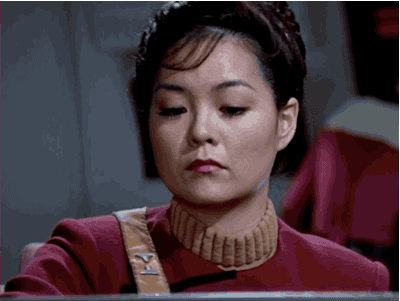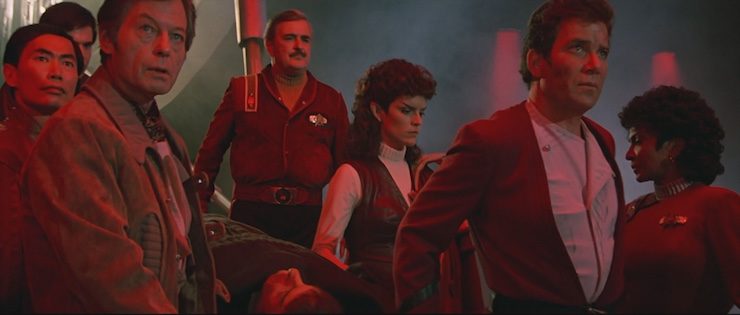Star Trek III: The Search for Spock, as an odd-numbered franchise entry, is often cited as proof of the “even=good, odd=bad” pattern. Certainly it’s the first film in the series made primarily for a specific marketing reason (“We have to get Nimoy back! It doesn’t matter if Spock’s dead!”). It’s a movie that has neither a real beginning or ending. But, given those caveats, I maintain that the film is still a surprising and powerful experience.
There will be spoilers.
I had the pleasure of seeing it on its original run, when we didn’t know there would be Trek movies 4-13, let alone four new TV series. For all we did know, this would be the final Trek movie ever. It certainly drew some hard lines: Kirk and his command crew abandoning their Starfleet careers, David Marcus dying, and the destruction of the Enterprise itself. Unlike most current movie series, with installments that feel more like episodes, STIII felt like an actual movie, where the story wrought fundamental changes on the characters and their universe. There was no sense that things would be back to normal by start of the next film, if there even was a next film.
Which brings me to three non-verbal, purely visual moments that emphasize just how good a movie this is. No, not the big ones, like Kirk falling backwards after his son is killed, or Spock raising his eyebrow to show he’s at least partly himself. These are even smaller moments that don’t so much advance the plot as help populate the Trek universe with real people (I use “people” here in the non-specist sense).
Make no mistake: Spock may be referenced in the title, but STIII is emphatically about James T. Kirk. As David Gerrold says, the best Trek stories boil down to, “Kirk has a decision to make,” and that’s never been more true, here. In this film, he faces his biggest decision ever, the one with the deepest personal cost (Edith Keeler notwithstanding): how far will he go on the off chance that he can help his dead friend? The answer, of course, is all the way.
The first moment I want to highlight happens when Kirk meets with Admiral Morrow after Sarek’s visit. Morrow not only refuses permission to allow the Enterprise to return to Genesis, he warns Kirk that continuing to press the issue could cost him his career.
Watch Kirk as Morrow speaks. Up until this moment, the scene is shot in a standard cut-to-who’s-speaking style, until Morrow lays it all out for Kirk. Then, instead of cutting to Morrow talking, the camera stays on Kirk as he listens, slowly zooming in so that you see the reality of the situation really register. It’s not a surprise to him: Kirk, being Kirk, already knows what he’ll lose if he persists. But in that moment, even as Morrow is warning him, Kirk makes his decision.
So, when Morrow finishes, Kirk apparently blows it off. “I had to try,” he says with a friendly grin, making it seem like the whole issue is over.
Of course, in the next moment he tells his crew, “The word…is ‘no.’ I am therefore going anyway.”
One of the real treats of STIII is that it gives not only the original crew moments to shine, but even the actors in bit parts. McCoy’s waitress and the alien pirate in the space bar, Uhura’s “Mr. Adventure,” and nervous Captain Esteban make impressions in roles that could have been dispensable.
One of the most perfectly timed moments, and the second I want to point out, comes when Jeanne Mori, playing the Grissom’s helm officer, reacts to the report that the Genesis effect has resurrected Spock. It’s a moment that lays bare the whole reason for this film’s very existence, and to play it straight would make it even more ridiculous. So the reaction is given, not to Captain Esteban or any of the other named characters, but to this nameless officer. The slow burn of her eyes as she recognizes the sheer ludicrousness of this development ensures that we’re laughing with the movie, not at it. Yes, we know this is silly, the moment tells us. Just go with it, though, and we promise it’ll be worth it.

The third moment occurs during the mind-meld montage at the movie’s climax. That scene hovers on the edge of camp goofiness, with the whole planet Vulcan combining their mental forces to effect a soul transplant, moving Spock’s katya out of McCoy and back into his regenerated body (imagine if they moved the wrong soul). Only the grim events that precede it (the death of David Marcus, the destruction of the Enterprise) stave off the giggles.
Since it’s a montage, it consists of slow, overlapping pans across various parts of the group: the high priestess T’Lar’s grim profile, the Vulcans all with their eyes closed, the Enterprise crew watching helplessly.
Well, most of the crew. Saavik, the Vulcan helm officer, stands with the Enterprise crew, yet closes her eyes and contributes her mental energy to the Vulcan effort.
This moment always carried a ton of symbolic Trek weight for me. The first Vulcan we ever met, Spock, served in Starfleet against the wishes of his father, a conflict that isn’t fully resolved until the end of the next movie. Also half human, Spock has to resist the urge to let that part of himself out, even as he’s surrounded by the best that humanity has to offer.
Saavik, introduced in the prior movie, is a young Vulcan trying to puzzle out human behavior; she wants to understand it so that she’ll be a better Enterprise officer (a callback to the character Xon from the abortive second Trek series). She does not wish to become human, just to understand them, and her efforts (from the comic ones in STII to her almost bitter dressing-down of David Marcus in STIII) allow us to see the human characters from a clear-headed outsider’s perspective.
Yet here, at the end, she stands with the Enterprise crew, yet joins in the Vulcan effort. Part of this, of course, is personal: Spock was her mentor, and she may (thankfully this is left vague) have gotten even more intimate with the younger version of his brainless self. So she has a personal stake in the outcome.
But this goes beyond the purely personal—it’s simply something a Vulcan would do. Group affiliations (in this case, Starfleet) do not preclude heritage. It’s a moment that, to me, echoes throughout the Trek universe, adding to the sense of reality and depth that—piece by piece, episode by episode, movie by movie—makes Trek so much fun. Of course Saavik is both Vulcan and Starfleet. She embodies (to borrow a phrase) the best of both worlds.
There are other fine moments, of course, both big and small, no doubt due to director Leonard Nimoy’s determination to let his actors act and not get swallowed by special effects or ensnarled in plot details. And as I said, this creates a sense of a universe populated with living beings who have their own opinions, interests, and lives.
The closest contemporary analogy I can think of to STIII is with The LEGO Movie. Both films were created primarily due to marketing concerns (I know, you could say that about all films, but seldom is it this blatant, and it certainly wasn’t back in 1983…), yet in both cases, the filmmakers entrusted with the project managed to go beyond the call and give us a real story with genuine emotions. And in both cases, that feels like something of a miracle.
 Alex Bledsoe grew up in west Tennessee an hour north of Graceland (home of Elvis) and twenty minutes from Nutbush (birthplace of Tina Turner). He’s been a reporter, editor, photographer and door-to-door vacuum cleaner salesman. His latest novel is Chapel of Ease, available from Tor Books.
Alex Bledsoe grew up in west Tennessee an hour north of Graceland (home of Elvis) and twenty minutes from Nutbush (birthplace of Tina Turner). He’s been a reporter, editor, photographer and door-to-door vacuum cleaner salesman. His latest novel is Chapel of Ease, available from Tor Books.










